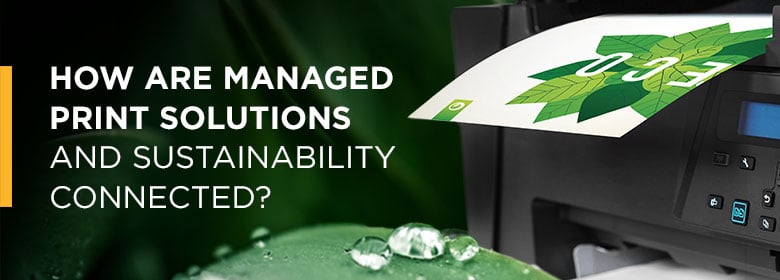
Sustainability is a hot topic these days. In private households, families are trying to reduce their environmental footprint. In businesses, employees and management are trying to do the same. There has been an increased push in recent years for businesses to become more sustainable. But how do managed print services (MPS) and sustainability align?
There are countless ways for businesses to improve sustainability but one of the best ways in with managed print services. Most people think of efficiency when they think of MPS but these services are far more than just efficiency improvements, although that may be one of the initial drivers to consider MPS. It’s important to remember that 50% of all waste in businesses is made up of paper. This isn’t just bad for the environment, it’s bad for the bottom line.
So, where do the goals of efficiency and sustainability meet when it comes to managed print services? This article will take a closer look at that very topic.
Modern Technology to Go Paperless
So many people get laser focused on the “print” portion of managed print services. The word is right there in the name so it’s certainly obvious why people would think that way. However, MPS is about much more than just putting ink to paper. In fact, one of the most essential parts of managed print services is reducing printing with better storage, organization, and data handling.
Using modern solutions in place of processes where paper was previously required is the key to reducing paper usage. Digitally signing documents, developing digital workflows, and making office culture changes are the first steps to sustainability. For many businesses, these may be gradual changes that lead to improve sustainability over time. For other businesses, like Idea Rebel, reducing paper waste is something they are incredibly serious about.
They refuse to use paper in their office. This can prove to be a challenge but, with the right solutions in place, Idea Rebel has been able to live up to their promise. Notes are taken on tablets, digital whiteboards are used for meetings, and secure storage is used for all company contracts which are digitally signed, of course.
Less Paper, Smaller Footprint
It should come as a shock to no one that reducing paper usage means reducing the size of a businesses’ environmental footprint. But how much of a difference does it really make? Adobe estimates that as much as 90% of office waste in the United States comes from paper waste. But what does it mean for businesses to reduce this waste?
A study from Catalog Spree and PaperKarma had some shocking revelations. If the United States could reduce paper waste by just 10% then it would save 1.84 metric tons of greenhouse gas emissions which is equivalent to taking 280,000 cars off the road. That’s a staggering number but exciting at the same time. With some smart changes around the office, many businesses could easily reduce paper waste by 10% with little to no negative effects on business process.
For example, UCAN is a non-profit serving 12,000 people. It was able to adapt and modernize workflows to reduce paper usage by 1.25 million sheets per year. Not only does this provide massive cost savings for the non-profit but it has also helped them become leaders in environmental stewardship and a shining example for other nonprofits and businesses to follow.
Don’t Forget About Economic Sustainability
It’s estimated that office waste is costing businesses billions of dollars per year. Every new ink cartridge, every new ream of paper, and every maintenance visit costs money in addition to the toll these things can take on the environment. Without managed print services, expenses can’t be managed effectively either. As the cost of printing increases, margins within the business are decreased. That’s right; environmental sustainability is good for the trees and it’s good for business.
Standard Chartered Bank implemented a paper reduction strategy with several methods they intended to use in order to reduce paper waste in their business including adapting paperless workflows, conducting paperless meetings, performing regular maintenance on printing devices to ensure efficiency, and more. They estimated that these changes could save up to 50% on their printing costs which were around $3 million per year. That’s up to 70 tons of paper reduced with basic changes in printing habits and examining more modern methods for data storage and sharing.
Managed Print Services and Sustainability
It’s easy to see how MPS and sustainability go hand-in-hand. Through improved printing processes, businesses can cut costs and reduce their environmental footprint. A sustainable business is one that’s ready for whatever the future holds. To learn more about managed print services and sustainability, or to book a managed print services assessment, contact Clover Imaging Group today.



 United States
United States
